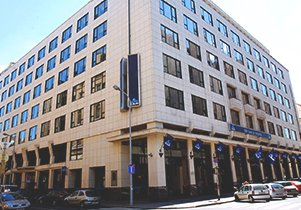the history of the Bank
Having started its operations on 1 January 1987, the birthday of K&H Bank coincides with the creation of the two-tier banking system in Hungary.
 The Bank was founded by the Hungarian State and some of the state’s legacy clients: companies in agriculture, the food industry, trade and tourism. In the period up to 1992, the Bank expanded its operations and clientele, launched new services and dynamically increased the number of its branches. As the country’s economy weakened, a good many clients also experienced the deterioration of their situation, which resulted in a significant rise in the distressed loan portfolio. Driven by this and the intention to continue to grow, the Bank underwent consolidation, which involved repeatedly raising its share capital and the infusion of subordinated loan capital. Thus strengthened, in 1996 the financial institution absorbed IBUSZ Bank, an affiliate focused on retail banking services, which it had already owned. This merger created a major universal bank also boasting the second largest branch network in the country. In the same year, K&H Bank joined VISA and Europay (today MasterCard) and started work on developing one of the widest bank card offerings in this country.
The Bank was founded by the Hungarian State and some of the state’s legacy clients: companies in agriculture, the food industry, trade and tourism. In the period up to 1992, the Bank expanded its operations and clientele, launched new services and dynamically increased the number of its branches. As the country’s economy weakened, a good many clients also experienced the deterioration of their situation, which resulted in a significant rise in the distressed loan portfolio. Driven by this and the intention to continue to grow, the Bank underwent consolidation, which involved repeatedly raising its share capital and the infusion of subordinated loan capital. Thus strengthened, in 1996 the financial institution absorbed IBUSZ Bank, an affiliate focused on retail banking services, which it had already owned. This merger created a major universal bank also boasting the second largest branch network in the country. In the same year, K&H Bank joined VISA and Europay (today MasterCard) and started work on developing one of the widest bank card offerings in this country.
In the first step of bank privatisation, in 1997 the European Bank for Reconstruction and Development (EBRD) as financial investor granted the Bank subordinated loan capital worth USD 30 million and thus strengthened its capital position. The tender process was won by Kredietbank of Belgium and Irish Life, an insurance company based in Ireland, first acquiring a 9.6 percent package of the Bank’s shares and then raising capital by USD 60 million. The conversion of EBRD’s subordinated loan capital into shares represented the next change in the shareholding structure. As a result, the Bank’s strategic investors, Kredietbank and Irish Life now held 23.1 percent each and EBRD owned 18.2 percent of the shares. The capital increase resulted in a bank with stable reserves and good capital adequacy even when measured by international standards, which enabled it to develop further.
In 2001 the Belgian shareholder, KBC Bank and Insurance Group, merged the Bank with the Hungarian affiliate of ABN AMRO of Netherlands. The merger also extended to the affiliates of the Banks, with the exception of Argosz Insurance (KBC’s non-life insurance company), LeasePlan (ABN AMRO’s vehicle fleet management company) and Mébit Insurance (ABN AMRO’s insurer).
Pursuant to its agreement with ABN AMRO Bank, KBC exercised its option agreement with its shareholder partners and in February 2001, i.e. preceding the merger, it bought out the share packages of Irish Life (17.9 percent) and Espirito Santo Asset Administration (7.33 percent), increasing its share in K&H Bank to 98.51 percent. The banks’ shareholders gave their consent to the merger at their annual general meetings held concurrently on 27 April 2001. Following approval by the Hungarian Financial Supervisory Authority (HFSA) and the Competition Authority, the Court of Registration registered the merged K&H Bank as of 1 July 2001. Its shareholders were KBC Bank with 59 percent of the shares and ABN Amro Bank with 40 percent.
The merger created one of the largest financial institutions in Hungary, with total assets of HUF 1,145 billion, a market leader position in the corporate banking business and second place in the retail segment. One year later, K&H Bank had successfully completed the work still outstanding from the merger as it launched its new, unified account management system across its retail branch network.
In 2002 K&H Bank was the first to launch a bank card carrying a microchip, one that was much more secure than magnetic strip cards and, besides storing data, also allows regular updates and serves as a means of personal identification. Nevertheless, the greatest novelty of the year was the launch of the first Hungarian guaranteed money market fund. When the subscription period ended, the portfolio of the K&H Fix Plus Investment Fund exceeded HUF 3.5 billion. Launched in February 2003, K&H Fix Plus 2 also attracted heightened demand. The outstanding success of these two investment funds made K&H Fund Management the third largest player on the fund management market. Since then, it has continued to enhance its business operations and improve its results dynamically year after year.
Kredietbank, the legal predecessor of KBC Bank, entered the Hungarian market as the winner of the privatisation tender of K&H Bank in 1997. From its initial 23 percent, KBC Group has by now increased its ownership share to 100 percent.